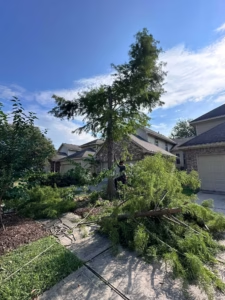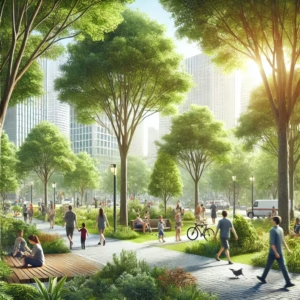Trees are among the most vital elements of our planet’s ecosystem. From producing oxygen to beautifying landscapes, the Benefits of Trees extend far beyond what meets the eye. In this blog post, we’ll explore these benefits in detail—covering environmental, economic, social, and mental health aspects—so you can fully appreciate why planting and preserving trees is crucial for our collective future.
1. Environmental Benefits of Trees
1.1: Oxygen Production
Perhaps the most well-known role trees play is producing oxygen through photosynthesis. This helps maintain a balance in the atmosphere, ensuring a healthy environment for all living creatures.
1.2: Carbon Sequestration
Trees help combat climate change by capturing carbon dioxide (CO₂) from the air and storing it in their trunks, branches, and roots. By doing so, they effectively reduce greenhouse gases and help slow global warming.
1.3: Soil Conservation
Trees prevent soil erosion with their intricate root systems. This stabilizes the ground, reduces runoff, and preserves the fertility of agricultural land. In addition, fallen leaves from trees decompose into organic matter, further improving soil quality.
1.4: Habitat for Wildlife
Forests and urban parks serve as natural habitats for a diverse range of wildlife. Protecting trees means providing shelter and nourishment for birds, insects, and other creatures, which preserves biodiversity.
1.5: Air Quality Improvement
By absorbing pollutants such as carbon monoxide, sulfur dioxide, and nitrogen dioxide, trees help purify the air. This leads to better respiratory health for people and a cleaner environment.
2. Economic Benefits of Trees
2.1: Increased Property Values
Well-landscaped areas with trees and greenery generally enjoy higher property values. This is especially true in urban areas where trees add aesthetic appeal and create a pleasant atmosphere.
2.2: Reduced Energy Costs
Strategically planting shade-providing trees around buildings can lower cooling costs during hot months. In colder seasons, trees act as windbreaks, reducing heat loss and lowering heating expenses.
2.3: Boosted Local Economy
Tree-lined streets, parks, and green corridors often attract visitors, bolster tourism, and support local businesses. These public spaces are ideal for recreational activities that benefit the economy.
2.4: Sustainable Timber and Non-Timber Products
Responsible forestry can supply timber for furniture and construction, as well as non-timber products like fruits, nuts, and latex. When managed sustainably, these products support local livelihoods while preserving forest health.
3. Social Benefits of Trees
3.1: Community Engagement
Public parks, community gardens, and tree-planting initiatives bring people together. These shared spaces foster stronger social bonds, encourage volunteerism, and improve neighborhood safety.
3.2: Educational Opportunities
Trees and forests serve as outdoor classrooms for schools and communities. Children and adults alike can learn about biology, ecology, and conservation through hands-on interaction with nature.
3.3: Improved Aesthetics
Green spaces with mature trees provide visually appealing landscapes, which contribute to a sense of pride and well-being in local communities. They can also reduce noise pollution, adding to a more peaceful environment.
4. Mental Health Benefits of Trees
Connecting with nature has a notable impact on mental well-being. Spending time among trees—whether in a dense forest or a small city park—can reduce stress, improve mood, and enhance overall mental health. For a deeper dive into this topic, check out our dedicated post on mental health benefits of trees, where we discuss how nature therapy can significantly improve psychological well-being.
5. How You Can Help Maximize the Benefits of Trees
5.1: Plant Trees Locally
Support community tree-planting projects or start your own. Choosing native species is essential to ensure they thrive in the local climate and support local wildlife.
5.2: Adopt Sustainable Practices
Reduce paper consumption by going digital when possible. Choose products that come from responsibly managed forests, and recycle or compost green waste.
5.3: Support Environmental Organizations
Donate time or resources to organizations dedicated to forest conservation and tree-planting efforts. Even a small contribution can help expand global reforestation projects.
5.4: Educate and Advocate
Share information about the Benefits of Trees with friends, family, and community members. Encourage local policies that protect existing trees and promote urban greening initiatives.
Conclusion
The Benefits of Trees are vast, touching every aspect of our lives—from climate regulation and economic growth to social well-being and mental health. By understanding their importance, we can make informed decisions that support both our local communities and the global ecosystem. Let’s continue planting, protecting, and cherishing trees for a greener, healthier future.
Remember: Each tree planted, each sapling protected, and every policy advocated for can make a meaningful difference in preserving the natural world we all depend on. By acknowledging the Benefits of Trees, you take the first step toward a more sustainable and thriving planet for generations to come.




